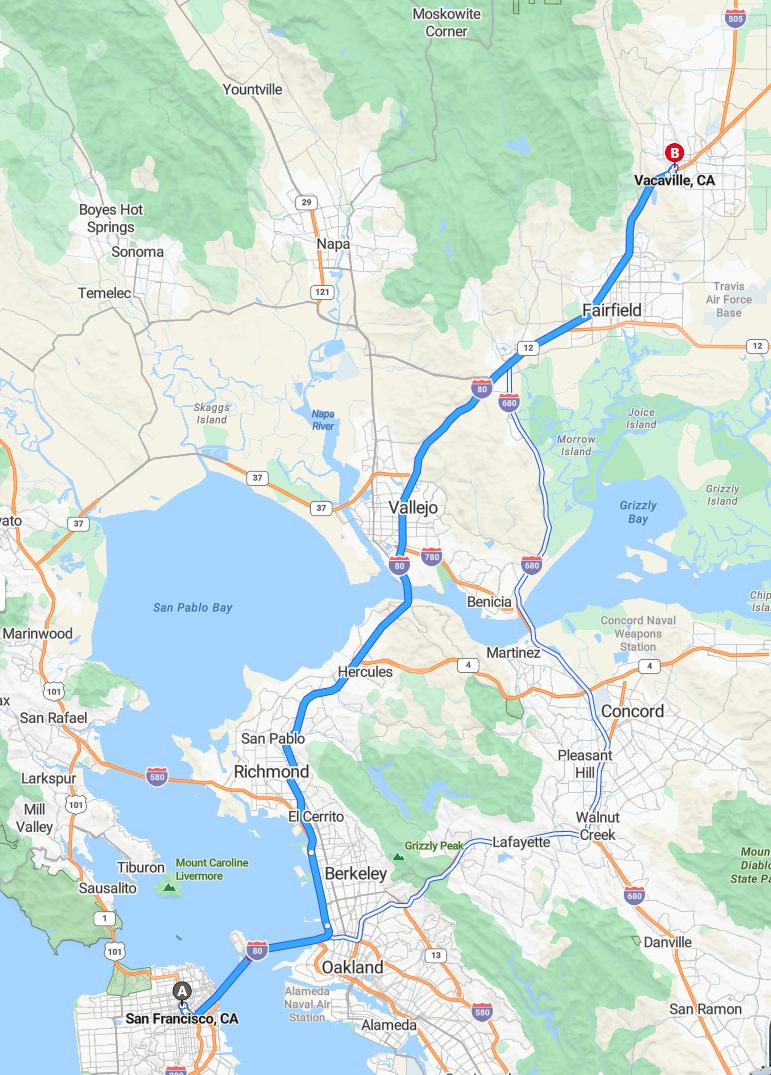Distance and estimated driving time
The drive from San Francisco to Vacaville typically takes around 56 minutes, covering approximately 54 miles along the I-80 East route. This scenic journey offers a convenient and efficient way to travel between these two locations. Traffic conditions and time of day may influence the duration, so planning accordingly is advisable. Overall, the trip provides a straightforward connection, making it suitable for both commuting and leisure travel.
Driving route
The scenic drive from San Francisco to Vacaville takes you through a diverse array of vibrant cities and scenic areas. Starting in the bustling city of San Francisco, you quickly pass through the culturally rich neighborhoods of Berkeley and the industrial zones of Richmond and San Pablo. As you continue north, the route brings you to Hercules, with its charming waterfront, and then to Vallejo, known for its historic sites and waterfront attractions. The journey concludes in Fairfield and finally in Vacaville, both renowned for their family-friendly communities and shopping centers. This route offers a blend of urban excitement and picturesque California landscapes, making it an enjoyable trip for travelers exploring the Bay Area and its surroundings.

Traffic conditions and peak hours
Traveling from San Francisco to Vacaville, traffic conditions can vary significantly depending on the time of day. During weekday mornings and late afternoons, especially between 7:00 AM and 9:00 AM and 4:00 PM to 7:00 PM, the route often experiences heavy congestion, particularly near San Francisco, Berkeley, and Vallejo. Outside of peak hours, traffic tends to flow more smoothly through cities like Richmond, San Pablo, and Hercules, making the drive faster and more predictable. Planning your trip to avoid these rush periods can help ensure a more efficient journey along this route.
Best departure times for minimal traffic
For a smooth drive from San Francisco to Vacaville with minimal traffic, it is best to depart early in the morning, around 6:00 to 7:00 am, when most commuters have not yet begun their day. Alternatively, traveling in the late evening after 7:00 pm can help avoid peak traffic hours, especially through busy areas like Berkeley, Richmond, and Vallejo. Avoiding weekday rush hours between 7:00 am to 9:00 am and 4:00 pm to 6:00 pm will significantly reduce travel time. Planning your departure outside of these peak periods ensures a faster, less stressful journey along the route through San Pablo, Hercules, Vallejo, and Fairfield.
Alternative routes and detours
When driving from San Francisco to Vacaville, alternative routes and detours can provide flexibility based on traffic conditions or road closures. One common option is to take the I-80 East directly through Berkeley, Richmond, and Vallejo, avoiding local streets. For a scenic detour, drivers might consider exploring the surrounding areas by connecting to CA-37 or CA-29, offering different views of the region. It's advisable to check real-time traffic updates before departure to select the most efficient route and avoid potential delays.
Road safety tips during the drive
When driving from San Francisco to Vacaville, it is important to follow essential road safety tips to ensure a smooth journey. Always stay attentive and avoid distractions, such as using your phone, to maintain full control of your vehicle. Adhere to the posted speed limits, especially when passing through busy areas like Berkeley, Richmond, and Vallejo, where traffic can be unpredictable. Lastly, make sure your vehicle is in good condition, and plan for regular breaks to stay alert and refreshed throughout the drive.
Points of interest along the way
Traveling from San Francisco to Vacaville, drivers can enjoy a variety of points of interest along the route. In Berkeley, the historic University of California campus and the vibrant Telegraph Avenue offer cultural and shopping experiences. As you pass through Richmond and San Pablo, waterfront parks and recreational areas provide scenic views and outdoor activities. Continuing through Vallejo and Fairfield, visitors can explore naval history at the USS Hornet Museum or enjoy local parks before reaching Vacaville, which is known for its family-friendly attractions and outlet shopping.
Parking options in Vacaville
Vacaville offers a variety of parking options to suit visitors' needs, including both daily and long-term solutions. The city features numerous public parking lots and garages located downtown and near popular attractions, providing convenient access to shopping, dining, and entertainment. Street parking is also available in many areas, often free or with designated time limits. Additionally, some shopping centers and businesses offer customer parking, making it easy for travelers to explore Vacaville comfortably.
Gas stations and fuel prices along the route
Traveling from San Francisco to Vacaville, there are several gas stations conveniently located along the route, including major brands such as Chevron, Shell, and Costco. Fuel prices vary across cities like Berkeley, Richmond, and Vallejo, with prices typically ranging from $4.50 to $5.00 per gallon, depending on the station and current market conditions. In Vacaville, travelers can find competitive rates at local service stations, making it an ideal spot for refueling before reaching your destination. It's advisable to check real-time fuel prices via smartphone apps to ensure you find the best deal along the route.
Weather forecast affecting driving conditions
The weather forecast indicates clear skies and mild temperatures along the route from San Francisco to Vacaville, which should facilitate smooth driving conditions. However, travelers should remain cautious of occasional fog or drizzle in the early morning hours, particularly near the Bay Area, which could reduce visibility and impact driving safety. As the day progresses, moderate temperatures and dry conditions are expected to prevail, supporting safe travel through cities such as Berkeley, Richmond, and Vallejo. It is advisable to stay updated on local weather reports to anticipate any sudden changes that might influence traffic flow and driving safety.
